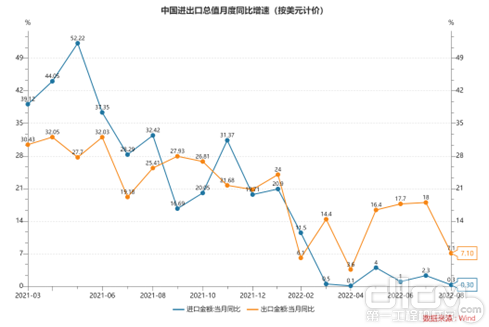On September 7, data released by the General Administration of Customs showed that China's total import and export value in the first eight months of this year was US$4.191 trillion, a year-on-year increase of 9.5%. Among them, exports were US$2.375 trillion, a year-on-year increase of 13.5%; imports were US$1.815 trillion, a year-on-year increase of 4.6%; trade surplus was US$560.52 billion.
August import and export data
Specifically, in August, the total value of China's imports and exports in US dollars was US$550.45 billion, a year-on-year increase of 4.1%. Among them, the export was 314.92 billion US dollars, a year-on-year increase of 7.1%; the import was 235.53 billion US dollars, a year-on-year increase of 0.3%; the trade surplus was 79.39 billion US dollars.

Monthly trend of China's import and export balance
In terms of RMB, the total value of imports and exports in August was 3.71 trillion yuan, an increase of 8.6% year-on-year. Among them, exports were 2.12 trillion yuan, a year-on-year increase of 11.8%; imports were 1.588 trillion yuan, a year-on-year increase of 4.6%; trade surplus was 535.91 billion yuan.

August import and export data
August import and export data,Why did export growth decline in August
In August, China's exports reached US$314.92 billion, a year-on-year growth rate of 7.1%, 10.9 percentage points lower than that in July.

Monthly growth rate of China's total import and export value
Wang Qing, chief macro analyst at Oriental Jincheng, also told The Paper that in the context of the global economic slowdown, overseas demand for Chinese exports may have cooled. Compared with the previous period, the boosting effect of high inflation in developed economies such as Europe and the United States on China's exports has weakened in August. In fact, this phenomenon has been reflected in July.
In terms of the base factor, Zheng Houcheng said that the base in the same period in 2021 will increase by 6.23 percentage points, which is also bad for the month-on-year export value in August.
Wang Qing also said that the year-on-year growth rate of exports in July 2021 was 19.2%, rising to 25.4% in August. The increase in the base of export growth in August last year will inevitably have a certain inhibitory effect on the year-on-year growth rate of exports in August this year. At the same time, the effect of concentrated shipments in the early stage basically subsided in August. High-frequency data shows that the year-on-year growth rate of foreign trade container throughput of the eight major ports in August weakened to -0.1%, compared with a year-on-year increase of 14.7% in July. The foreign trade cargo throughput of coastal ports also decreased from a year-on-year increase of 7% in July. It was down 1% year-on-year.
Wang Qing said that the growth rate of exports declined in August, but it still showed strong resilience. The recent domestic epidemic fluctuations have limited impact on manufacturing capacity and logistics and transportation, and under the influence of many factors, overseas still rely heavily on "Made in China". At the same time, the RMB has depreciated against the US dollar to a certain extent since April (the maximum depreciation rate is close to 10%), which will have a certain promotion effect on exports in August. Finally, the recent domestic policy to stabilize foreign trade has continued to exert force, which will also have a certain supporting effect on exports.
Import growth down year-on-year
In August, China imported US$235.53 billion, a year-on-year growth rate of 0.3%, down from 2.3% in July.
Wang Qing said that the low-level decline in import growth in August was related to the higher base in the same period of the previous year, and the recent general decline in international commodity prices will also have a certain pull-down effect on the growth of imports. At the same time, under the background of declining real estate investment, the current domestic demand for upstream raw materials is generally weak, which is a fundamental factor for the recent slowdown in import growth.
Wang Qing also said that it is expected that the domestic economy will maintain the momentum of recovery in the future, but it is unlikely that the import demand will expand significantly. In addition, the international commodity prices are still on a downward trend, and the import growth rate will generally remain low and fluctuating for a period of time in the future.
Zhou Maohua, a macro researcher at the Financial Market Department of China Everbright Bank, told The Paper that the growth rate of imports slowed down again in August, mainly because Chinese demand was in the recovery stage and the overall situation was weak; international commodity prices were running high, and the price effect weakened import demand; at the same time, The impact of the high base of imports last year.
"Imports are gradually improving, but the growth rate is expected to remain low. The main reason is that the country has further introduced a combination of policies to expand domestic demand, and the steady recovery of domestic consumption and investment demand will help drive the improvement of import demand; but the prices of energy and some raw materials continue to remain high. Due to the impact of the high base last year, foreign trade imports are still at a low level." Zhou Maohua said that at present, foreign trade continues to show a pattern of strong exports and weak imports, and the trade surplus remains high.
How will foreign trade go in the future?
Looking forward to September, Zheng Houcheng said that at the Jackson Hole annual meeting, Fed Chairman Powell's speech was of a strong "hawkish" color, and it is expected that the Fed will continue to raise interest rates by 75 basis points in September. This month recorded a year-on-year 9.10%, a new high since the data was recorded in January 1997. It is expected that the European Central Bank is likely to raise interest rates significantly. Against this background, it is expected that the global manufacturing PMI of JPMorgan Chase will continue to be under pressure and decline in September. Breaking the line of prosperity and decline, it is bad for the CRB index in September year-on-year, and it is negative for the month-on-year year-on-year of September export value from the perspective of quantity and price.
Zheng Houcheng also said that the export value in August and September 2021 recorded 25.41% and 27.93% year-on-year respectively, and the base rose slightly, which was bad for September's export growth. What is bullish for the growth rate of exports in September is that the RMB exchange rate continued to depreciate from April to August. To sum up, under the suppression of the decline in quantity growth, the decline in price growth and the upward base, it is expected that the export value in September will likely be under pressure year-on-year.
Wang Qing also said that with the increase in the export base in the same period last year, the impact of the overseas economic downturn on China's exports was further reflected, and the pulling effect of the rising prices of export commodities tended to weaken.
Wang Qing said that it is expected that the growth rate of exports in September may further decline to around 5.0%. Next, under the background of high base and weak external demand, the fluctuation of China's export growth rate will be the basic trend. This means that steady growth in the second half of the year will rely more on domestic demand. It is worth mentioning that the recent rapid decline in the exchange rate of the RMB against the US dollar may have a certain driving effect on future exports, which is also a manifestation of the role of the flexible exchange rate as an automatic macroeconomic stabilizer. However, historical data suggest that the boost to exports from a devaluation of the renminbi should not be overestimated.
Source: The Paper

 粤ICP备2021076742号
粤ICP备2021076742号